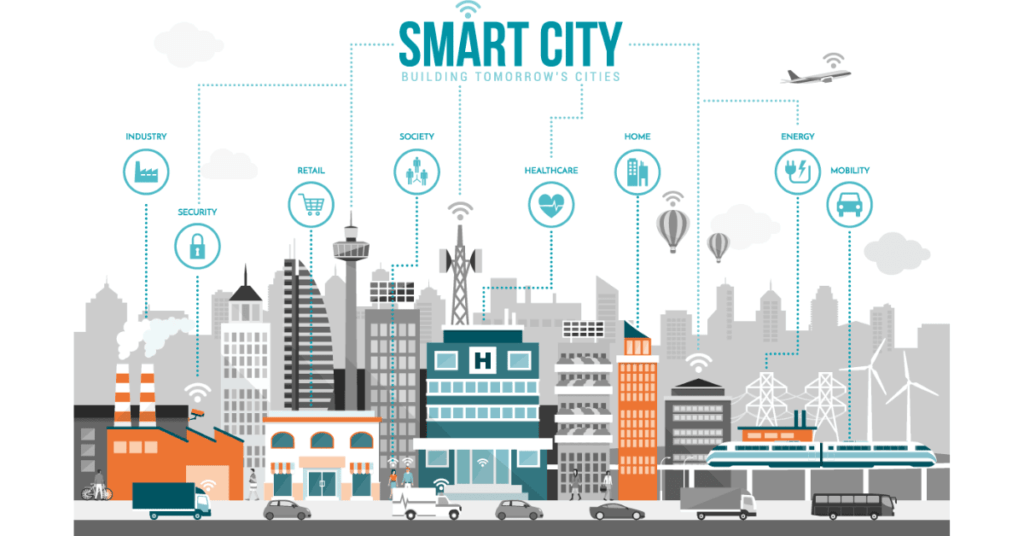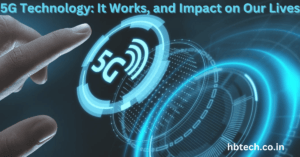With more people moving to cities every day, urban areas are facing big challenges like traffic, pollution, and limited resources. This is where “smart cities” come in. . Smart cities use technology to make daily life easier, more sustainable, and more efficient for everyone. Through digital tools, sensors, and data, these cities are finding new ways to improve everything from transportation to public safety. Let ’s take a closer look at what makes a city “smart,” the tech behind it, and how it’s changing urban life.
About Smart City
A smart city uses technology to help manage and improve city services. Smart cities rely on the Internet of Things (IoT) – a network of connected devices – to gather data from things like streetlights, public transport, and water systems. This data helps city officials make better decisions, respond quickly to problems, and improve services like waste collection and energy use. The main goal is to make cities more livable, sustainable. and safe.

For example, smart traffic lights can change based on real-time traffic to reduce congestion. Streetlights can dim when no one is around , saving energy, and waste bins can alert collection services when they’re full, helping keep streets cleaner.
Technologies Powering Smart Cities
Smart cities depend on several key technologies;
1. Internet of Things (IoT):
IoT connects everyday devices so they can share information. In a smart city, sensors on roads, buildings, and vehicles collect data to improve services. For example , sensors on roads can help manage traffic, while sensors in waste bins notify when they’re ready for collection, improving efficiency.
2. Artificial Intelligence (AI) and Data Analytics:
AI analyzes data from IoT devices to help cities respond quickly to issues or even predict future needs. For example, AI can help plan for peak energy use or identify potential safety risks through surveillance. Cities can use this data to anticipate traffic jams, energy demands, or even emergencies.
3. 5G Networks:
The rollout of 5G, which offers faster and more reliable internet, is a huge step for smart cities. It allows devices to connect instantly, which is essential for real-time services like autonomous vehicles and emergency response.
4. Renewable Energy and Smart Grids:
Smart cities are also about sustainability, so they’re using more renewable energy and creating smart grids. Smart grids can balance energy demand and supply in real time, preventing energy waste and making it easier to use clean energy sources like solar and wind.
How Smart Cities Improve Daily Life
Smart cities are transforming everyday urban life in many positive ways:
1. Sustainable Transportation:
In smart cities, public transportation can run on real -time data. Buses and trains adjust schedules to reduce wait times, and electric or autonomous vehicles help lower emissions. Some cities even use bike and scooter-sharing programs to encourage people to use eco-friendly transportation .
2. Better Energy Use:
Smart cities use energy-efficient systems to help reduce waste. Smart grids and energy meters give people a better idea of their own energy use, and buildings can adjust lighting, heating. and cooling based on occupancy, all of which helps save energy.
3. Smarter Waste Management:
Smart waste systems make trash collection more efficient. Bins with sensors can send alerts when they need emptying, so collection routes can be planned to avoid overflowing bins. Some cities even turn waste into energy, helping to reduce landfill use and generate extra power.
4. Public Safety and Health Innovations:
Safety is a big focus in smart cities. AI-powered cameras can spot unusual activity and alert emergency responders. In healthcare, smart cities use remote monitoring and telemedicine to improve access to medical care. During emergencies, smart systems can help dispatch services more quickly.
Benefits and Challenges of Smart Cities
Benefits:
Smart cities help make life easier, safer, and more sustainable. They reduce traffic, save energy , and improve public services like healthcare and waste management. They also create a cleaner environment by cutting down on pollution and conserving resources,
Challenges:
Building a smart city isn’t easy. Setting up and maintaining these technologies is costly, and data privacy is a major concern. Cities need strict data protection measures to keep personal information safe. Upgrading infrastructure to support these advanced technologies, like 5G, can also be challenging for some areas .
Examples of Smart Cities Worldwide
Several cities around the world are leading the way in smart city development :
- Singapore: Singapore’s “Smart Nation” initiative focuses on using data to make urban life easier. It uses sensors to monitor air quality, manage traffic, and enhance public safety.
- Barcelona: Barcelona is a pioneer in using smart technology to improve daily life. Its smart streetlights save energy by adjusting brightness based on activity, and digital bus stops provide real-time travel information.
- Amsterdam: Known for its smart transportation, Amsterdam has invested in electric vehicles, bike-sharing programs, and smart traffic signals , creating a more eco-friendly urban space.
Future of Smart Cities
Smart cities are just getting started, and the future holds even more exciting possibilities. We may soon see fully autonomous public transportation, AI-powered healthcare, and cities that can respond instantly to changing need s. By embracing these advancements, cities can better serve their communities and protect the environment.
Smart cities show us what urban life can become —more connected, efficient, and sustainable. As technology evolves, smart cities will continue to grow and improve, creating urban spaces where quality of life and environmental sustainability go hand in hand.
Frequently Asked Questions(FAQs)
What is a smart city?
A smart city is an urban area that uses technology, like sensors and data analytics, to manage city services more efficiently. It aims to improve residents’ quality of life by optimizing resources, reducing waste, and addressing issues like traffic, pollution, and public safety.
What technologies are essential for smart cities?
Key technologies for smart cities include the Internet of Things (IoT) for real-time data collection, Artificial Intelligence (AI) for analyzing and predicting city needs, 5G for faster connectivity, and smart grids to manage renewable energy and reduce waste.
How do smart cities improve transportation?
Smart cities enhance transportation by using real-time data to adjust public transit schedules, reduce congestion, and introduce eco-friendly options like electric vehicles and bike-sharing. This makes commuting easier, faster, and better for the environment.
What role does renewable energy play in smart cities?
Renewable energy is a priority in smart cities, helping to reduce emissions and create a sustainable energy supply. Smart grids balance energy demand and supply in real time, making it easier to integrate sources like solar and wind.
How is public safety improved in smart cities?
Smart cities use AI and data to improve public safety by monitoring public areas, identifying potential risks, and allowing quick response. Surveillance technology and emergency response systems can detect unusual activity and help direct services where they’re needed most.
What are the main benefits of living in a smart city?
Smart cities offer a cleaner, safer, and more efficient urban environment. They reduce traffic, save energy, improve waste management, and provide better public services like healthcare, all of which contribute to a higher quality of life.
What are the challenges of creating a smart city?
Building a smart city is costly, and maintaining the technology can be challenging. Privacy concerns are also an issue, as smart cities rely on data collection. Cities must ensure that residents’ personal information is protected and that infrastructure can support emerging technologies.
Which cities are leading the way in smart city development?
Cities like Singapore, Barcelona, and Amsterdam are pioneers in smart city development. They use smart technologies for transportation, waste management, energy efficiency, and public safety, serving as models for future urban planning.
What does the future of smart cities look like?
The future of smart cities includes more advanced technology like fully autonomous public transport, AI-driven healthcare, and increased use of renewable energy. As technology improves, smart cities will continue to evolve, offering more connected and sustainable living environments.
Related Posts
- 2-in-1 Laptops: Tablets and Laptops in One
- 5G Technology: What It Is, It Works and Impact on Our Lives
- 8K Gaming on a Laptop: Is It Worth It?
- A Simple Guide to Remote Work: Work from Anywhere, Anytime
- A Visit to the Museum of Jurassic Technology
- Affordable AI Solutions for Small Businesses









